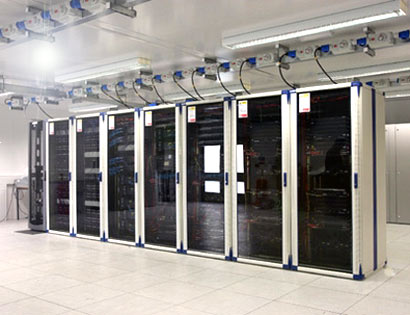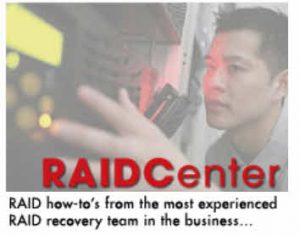
Ask a question, request a quote or check recovery status. Call us.
We are ready to help you recover your data 24 hours/day, 7 days/week!
HDRG’s RAID Data Recovery Service

RAID hard drive failure is a difficult situation for any company to be in. Because many RAID hard disk drive configurations are set up specifically for redundancy on mission critical data storage, or applications such as Microsoft Exchange servers or Oracle database servers, restoring them can mean the difference between profit and loss for many companies. But RAID drive failure is not necessarily an emergency issue.
Contact us here for a free RAID system repair consultation.
Although RAID array systems offer superb performance and increase speed and availability of data, they can and do fail under certain circumstances. Hard Drive Recovery Group has extensive experience with successful RAID data recovery, on both spanned and striped RAID systems.
In most cases, we require only the drives or storage devices to recover the data, and because of the high importance of most RAID systems, we consider them a top data recovery services priority – which means much quicker hard drive data recovery and return of your data immediately.
Contact us here for a free evaluation today!
Single Failed RAID Drives and the Simple RAID Repair
If you’ve arrived at this page looking for RAID recovery services, you’ve come to the right place. First, congratulations for doing the search. Many IT administrators automatically assume that they are up to the job when it comes to all computer problems, including RAID array and hard drive failures. Ninety nine times out of a hundred, especially if the issue is an actual mechanical hard drive issue, this is not the case.
Lets face it, RAID servers are only set up in that configuration because they contain important data like Microsoft Exchange Servers, Oracle or SAP data. Recovering mission critical data is the number one priority of Hard Drive Recovery Group, and we have all the tools to do it safely.
What is RAID?
RAID means “Redundant Array of Independent Disks”. A RAID system represents multiple disk drives on a computer as a logical data store and also utilizes disk mirroring techniques and diffraction techniques for protection and faster access. Disk mirroring is when the data is divided up onto multiple drives. Disk striping is a method of partitioning the data into separate files that results in a significantly faster read/write speed. RAID configurations offer various data privacy features.
— Hard Drive Recovery Group (@hdrecoverygroup) March 12, 2022
What To Do When RAID Failure Strikes
If you experience an unexpected RAID failure, particularly one which has mechanical or physical disk issues, or where there have been more than a single drive failure, your best bet is ALWAYS to shut down the system and call a professional RAID restoration engineer about proven data recovery solutions. Because of the high value of data typically saved on RAID arrays, a RAID failure is NOT the time to “flex” or “be a cowboy” when it comes to repairing the stack. The RAID recovery process is complex, and working with multiple hard disks to recover lost data is best reserved for data recovery experts. Instead, consider it a good time to seek experienced help to ensure a successful RAID data recovery.
Here are some actions you SHOULD NOT TAKE if your RAID array fails:
RAID reset – While this action does have some logic, it can be a terrible idea in cases of drive damage.
Re-Inserting RAID disks into the array – Again, your software or hardware driven RAID has broken the array for a reason.
Using Chkdsk or fsck. – A good idea with many disk failures, but NOT when they’re stacked in a RAID array.
Attempt To Read From Drives With SMART Errors – When your system is saying, “Hey. These disks are bad.” Your answer should be, “how do I avoid using them?”
Run data recovery software – We know, it’s quick and simple to download a new “data recovery software”, in hopes of “clicking a button and we’re done.” With physical hard disk issues, however, this can be catastrophic.
Why Do RAID Arrays Fail?
RAID configurations were designed to be as robust, speedy and redundant as possible, but they are far from indestructible. While it is relatively uncommon, even a single hard disk failure can cause issues within a RAID array, and can cause data loss and serious consequences for your company’s computing environment. Some typical causes of RAID failure include:
- Single or multiple drive failures within the array
- Intentionally or accidentally formatted partitions
- Infection by Virus or Malware
- File system corruption
- RAID controller failure
- Power surges
- Incorrectly performed RAID rebuilds
Most Common Unexpected RAID Failure Causes by Frequency
RAID Controller Failure – Hardware RAID servers include a controller card that manages I/O access between the array’s hard disks and the operating system. Catastrophic failures brought on by power surge or component failure (including hard drive clicking) are particularly hard on non-redundant RAID arrays, including RAID 0, which can destroy the array and the data contained on it.
Operating System Not Found – When the RAID controller cannot find the files to boot the operating system, you probably have a major problem. Although the cause of this type of error may be a number of things, typically a server hardware or configuration error is your prime suspect.
Multiple Hard Disk Failures – Different RAID configuration levels have different fault tolerance – so when the number of disk failures is greater than that tolerance, data in the array may be damaged, and may become lost or corrupted. As an example, with a three disk RAID 5 configuration, two failed disks can destroy the array and ensure the controller cannot rebuild the stack and recover data.
Server Fault – Common computer issues such as a motherboard failure or damage to the SATA controller can destroy a RAID array. Beware of taking any action outside of calling for help if you suspect this.
RAID Rebuild Failure – A single failed disk will often cause the RAID controller to attempt to rebuild the array. If during the array an incorrect disk type or size is used, major problems can occur.
Frequently Asked RAID Data Recovery Questions
Can you perform remote data recovery on my RAID system?
In a smaller percentage of cases with RAID systems, remote RAID data recovery is possible. But after over 30 years of experience recovering data from RAID servers, it pains us to admit that these kind of failures are rare, and are only in cases where there has been no physical damage. In cases where there is data loss due to mechanical or physical failure, we recover data in our certified clean room lab.
How much does RAID recovery typically cost?
We have outlined some of the factors for RAID data recovery costs here. But to summarize, data recovery costs will vary due to factors which include: number of drives, operating system, how the failure occurred, RAID configuration level and of course the size of the data loss.
Hard Drive Recovery Group has always offered no-risk RAID diagnostics, which basically means, “if no data is recovered, there is no charge.” Still, our RAID repair lab operates daily, and we rarely run into completely unrecoverable RAID arrays.
Does the operating system affect the RAID data recovery process?
Yes, but this generally has more to do with the RAID’s file system than it does its OS. Our RAID team has proprietary utilities for all mainstream file systems, including the most popular, which are Linux, Unix, Windows, Solaris, Mac OS or Windows.
What type of RAID data recovery level offers the quickest service?
We offer expedited 24 hour and 48 hour emergency RAID data recovery services for companies that cannot afford to wait. As long as the RAID array was powered down as soon as failure symptoms were discovered, and there was no attempt to rebuild a damaged RAID array, our expedited services often prove an excellent fit for emergency data recovery. Remember to always power down your RAID array once problems are discovered to minimize the time and effort it takes to recover data.
How does my RAID configuration level factor into HDRG’s data recovery process?
Hard Drive Recovery Group has been recovering RAID arrays for 30+ years, and we can recover data from virtually any RAID configuration in our dedicated RAID recovery laboratory. Certainly the wide array of configuration options can make data recovery more difficult in specific failure situations, we are experts at working with nested and complex RAID arrays. Our RAID data recovery success rate is 98%.
Choosing The Right RAID Recovery Service
Calling on the right service when your RAID server crashes is key to ensuring your data is safe and recoverable. In the  past handful of years, the data recovery industry has exploded with new competition, essentially smaller computer shops equipped with data recovery software looking to take in volumes of business at low prices. This kind of data recovery service is somewhat like rolling the dice in Vegas you may get your data, or you may not, but for prices like $99 (in some extreme cases), it seems like a fair gamble to some people.
past handful of years, the data recovery industry has exploded with new competition, essentially smaller computer shops equipped with data recovery software looking to take in volumes of business at low prices. This kind of data recovery service is somewhat like rolling the dice in Vegas you may get your data, or you may not, but for prices like $99 (in some extreme cases), it seems like a fair gamble to some people.
If you’re looking for a professional RAID data recovery service, however, a gamble is probably not what you want to take. You probably want a team of RAID recovery engineers with the experience that comes with recovering hundreds of RAID servers a month for over a decade.
You probably want a shop that has a Class 100 clean room, if only to be assured that your RAID server recovery will be done in a professional, risk free environment. You definitely want a company that understands complex file system structures as well as RAID controller and hardware failure issues.
You probably want to deal with data recovery experts that will keep you informed all the way, and pickup and drop off your RAID server within 24 hours. If those are all the case, you are likely looking for a shop like HDRG.
RAID Array Failures
As an award winning RAID data recovery service, we see thousands of RAID recovery jobs annually and consider data safety to be our first priority. Circumstances vary widely, as might be expected, but at the core of any RAID failure is drive loss or failure within the array.
An important fact to note if you have a RAID 5 and above system is that if a single hard drive fails, whether it be simply corrupted or physically burned out, your RAID array may be very recoverable using software provided by you RAID controller manufacturer. When this is the case, we still recommend you work with someone familiar with the process, but certainly this is a case where you can recover your failed RAID on your own.
Double Trouble
With a double RAID hard disk drive failure, you’re likely out of luck on a do it yourself basis. Calling a professional is likely your only avenue if you want to recover the data. This is because special tools are required, and certainly in cases where hard disk drives have physically failed, they must be restored first and imaged even before recovery can begin. We warn against attempting to recover a dual drive failure RAID only because so many of our clients do so and many corrupt the array to the point where little, or even NO data can be recovered.
The RAID Data Recovery Process
When recovering data from RAID 10 arrays, or even RAID 5 recovery, we typically mirror the complete drive volumes and then process the total array as image files, to ensure all of your data is safe. Once we have recovered the data to our data recovery servers, we evaluate the array images to determine if corruption has occurred, and work on repairing it. Our proprietary software extracts data from the image files, or if a drive image is difficult to create, we simply reconstruct the data in the same way that a RAID rebuild process is performed.
During all stages, we closely monitor the array configuration and array file system to determine why exactly the array failed. This information may be critical to future RAID systems your company may set up.
SAN & NAS RAID Recovery
A SAN and NAS system require similar methodologies to recover data if data is lost in a RAID configuration. Hard Drive Recovery Group’s team of RAID engineers is dedicated to the reconstruction of complex file systems and blocks that make up your array. We have designed and built a number of NAS-specific data recovery tools in order to properly assess, then restore your RAID environment. These include proprietary NAS-based storage and san-NAS NAS-based systems and the nonstandard file systems.
Strong RAID Manufacturer Relationships
Today’s enterprise server market is truly a broad and varying one, with RAID servers leading the pack in terms of complexity and hardware choices. Depending on your RAID system’s manufacturer, unique components and configurations require experience and real in depth knowledge of various proprietary data structures. Our certified engineers typically receive hardware and RAID system training refreshes at least twice per year, ensuring that your RAID recovery services are performed with real effectiveness.
We have technical alliances with all major RAID controller manufacturers, and each of these alliances have enabled our engineers to develop proprietary tools and techniques that guarantee complete data recovery. We work with a variety of RAID devices including network attached storage units, arrays built using solid state hard drives, regular hard disk drives, and other more complex storage environments. Our data recovery services are certified by all manufacturers so your server’s original warranty is never in question.
Ready 24 Hours A Day
Our experienced RAID data recovery engineers are ready to receive your call and consult with you during your data recovery services emergency, 24 hours per day, seven days per week. We welcome your questions, and look forward to hearing from you today.



